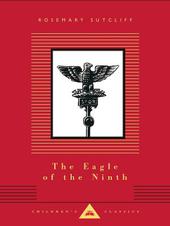
|
The Eagle of the Ninth
Hardback
Main Details
| Title |
The Eagle of the Ninth
|
| Authors and Contributors |
By (author) Rosemary Sutcliff
|
|
Illustrated by C. Walter Hodges
|
| Series | Everyman's Library CHILDREN'S CLASSICS |
|---|
| Physical Properties |
| Format:Hardback | | Pages:304 | | Dimensions(mm): Height 210,Width 20 |
|
| ISBN/Barcode |
9781857155204
|
| Classifications | Dewey:823.914 |
|---|
| Audience | |
|---|
| Illustrations |
22 b/w drawings
|
|
Publishing Details |
| Publisher |
Everyman
|
| Imprint |
Everyman's Library Children's Classics
|
| Publication Date |
24 September 2015 |
| Publication Country |
United Kingdom
|
Description
Heralded as the best historical novel for children ever written, and one of the outstanding children's books of the twentieth century, Rosemary Sutcliff's The Eagle of the Ninth, an adventure story set in Roman Britain, remains as popular now as when it was first published in 1954. The Everyman edition reprints the classic black and white illustrations of C. Walter Hodges which accompanied the first edition in 1954. Around the year 117 AD, the Ninth Legion, stationed at Eburacum - modern day York - marched north to suppress a rebellion of the Caledonian tribes, and was never heard of again. During the 1860s, a wingless Roman Eagle was discovered during excavations at the village of Silchester in Hampshire, puzzling archaeologists and scholars alike. Rosemary Sutcliff weaves a compelling story from these two mysteries, dispatching her hero, the young Roman officer Marcus Aquila, on a perilous journey beyond Hadrian's Wall to find out what happened to the discredited legion in which his father served, and to salvage, if he can, its Eagle and its honour. All the essential elements of a classic adventure are here - the daring quest, the uncovering of the secrets of the past, and a nerve-racking escape across the mountains, pursued by vengeful tribesmen. But it is the human element which triumphs, and one of the most memorable scenes in the book is Marcus appealing to a crowd baying for blood to save a young British gladiator from certain death during the Saturnalia Games. Proud son of a Brigantian chieftain, Esca becomes his slave, then his freedman, and the indispensable companion of his travels. The Eagle of the Ninth is partly the story of their growing friendship, crossing the divide created by conquest and colonialism; and partly Marcus's journey of self-discovery as he learns of his father's fate and comes to terms with the end of his own military career. At the end he embraces a different, more hopeful future - not in Rome but 'under the pale and changeful northern skies' - acquiring a farm in the Downs, and marrying the girl next door. The Eagle of the Ninth has all its author's hallmark qualities - a mature and complex story, a wealth of historical detail, cultural sensitivity, wit and compassion. Above all, Sutcliff is able to conjure up the atmosphere of a distant age in a totally convincing way. It is hardly surprising that her work would set the standard for all historical fiction to come.
Author Biography
AUTHOR BIOGRAPHY Rosemary Sutcliff was born in 1920 in West Clanden, Surrey. With over 50 books to her credit, Rosemary Sutcliff is now universally considered one of the finest writers of historical novels for children. Her first novel, The Queen Elizabeth Story was published in 1950. In 1959 her book The Lantern Bearers won the Carnegie Medal. In 1974 she was highly commended for the Hans Christian Andersen Award and in 1978 her book, Song for a Dark Queen was commended for the Other Award. In 1975, Rosemary was awarded the OBE for services to Children's Literature and the CBE in 1992. Unfortunately Rosemary passed away in July 1992 and is much missed by her many fans. ILLUSTRATOR BIOGRAPHY Cyril Walter Hodges (1909-2004) was an English book illustrator at the height of a distinguished career in the 1950s and '60s when he illustrated some of Sutcliff's early works- The Queen Elizabeth Story, The Armourer's House, Brother Dusty Feet, Simon and The Shield Ring. In the same period he also illustrated well-known children's authors William Mayne (A Swarm in May) and Ian Serraillier (The Silver Sword). His drawings are very much in the tradition of 19th-century book illustration. Hodges was a leading scholar of the Elizabethan theatre and himself the author of a number of books including Columbus Sails (1939) and Shakespeare's Theatre (1964), which he lavishingly and lovingly illustrated.
ReviewsThose books are colossal. They are fantastic. -- David Mitchell on The Eagle of the Ninth trilogy I found myself caught up in [The Eagle of the Ninth] all over again, when the film version appeared in 2011. Fifty years on, I found its you-were-there deciption of Roman Britain and gripping plot as beguiling as ever... Re-reading Sutcliff, I realise just how un-condescending to younger readers her style and vocabulary are ... More important, the bok taught the younger me about friendship, courage and integrity. Sutcliff's heroes are models of how to be good people, but never priggish or unbelievable... -- Sally Hawkins * The Sunday Times * Decades later, I can still hear echoes of The Eagle of the Ninth in my head: the chink of mail, the tired beat of the legionaries' feet. * The Independent * These tales of Roman Britain have yet to be surpassed for their non-patronising prose and adult dangers. Sutcliff makes Classics and archaeology uniquely thrilling for children. -- Amanda Craig * The Times *
|